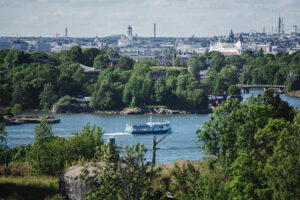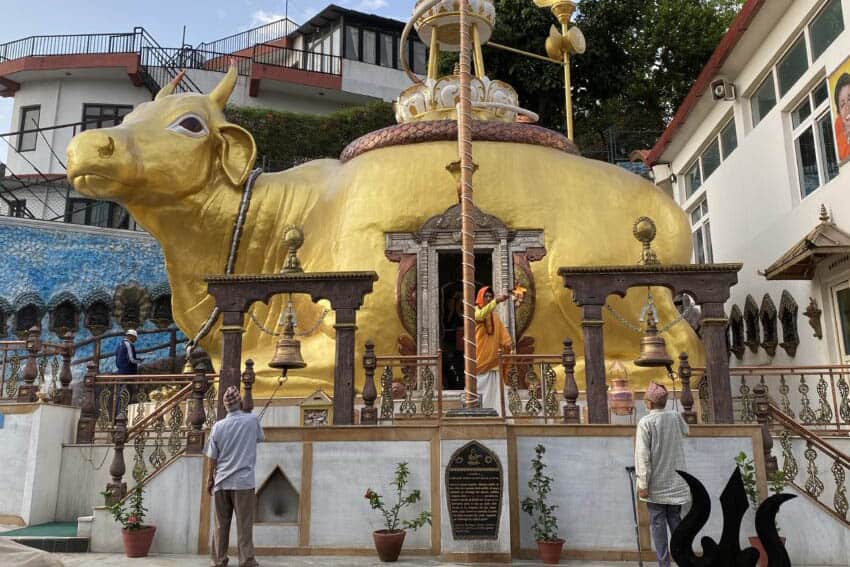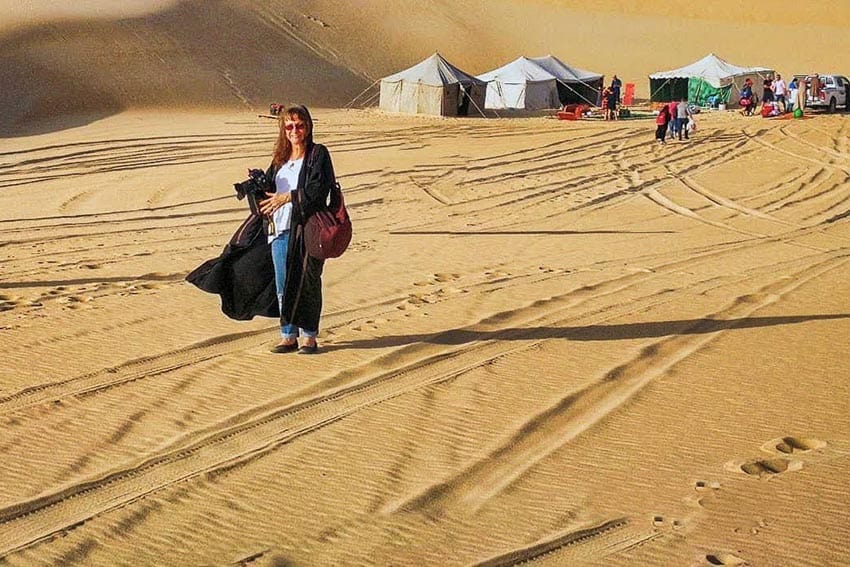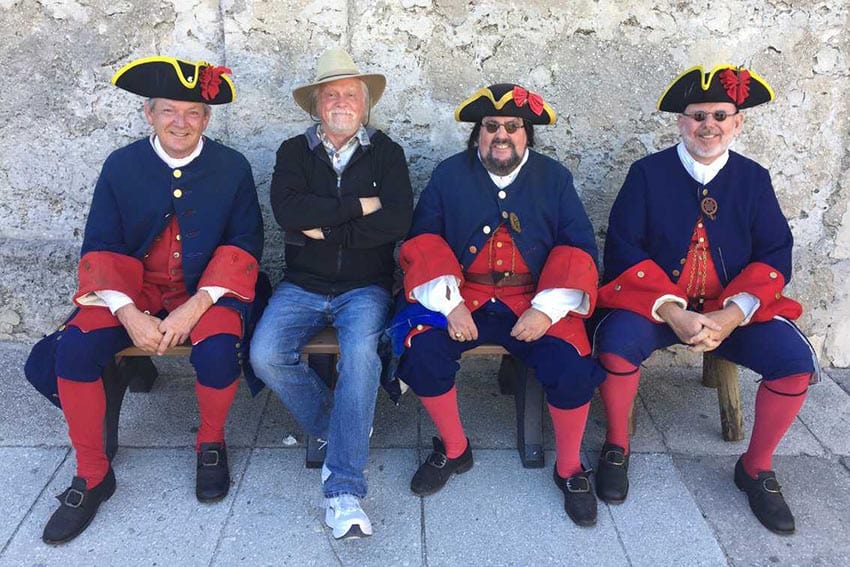
“A New Pocket in a Smaller World”: Saudi Arabia Wants to Meet You
By John Henderson

Saudi Arabia finally opened its door and I walked through to see tourism’s rising star off the beaten path. I wanted to beat the rush.
A hundred million may be pouring through in the next 10 years.
That’s the plan for Mohammed Bin Salman, Saudi Arabia’s youthful crown prince who’s trying to reform one of the most mysterious and criticized countries in the world.
In late September 2019, Saudi Arabia began offering tourist visas for basically the first time. Except for a brief period from 2007-09, the only reasons one could enter the kingdom were for business or the Hajj, the Muslims’ pilgrimage to Mecca.
Bin Salman, known as MBS, wants to diversify the kingdom from its oil-dependent economy. In 2016 he launched Saudi Vision 2030, a massive project that includes a $500 billion man-made city on marine land, 50 luxury islands off the Saudi coast, and a plethora of hotels.
With 100 million tourists over the next 10 years, he hopes to jump tourism’s contribution to the gross domestic product from 3-10 percent.
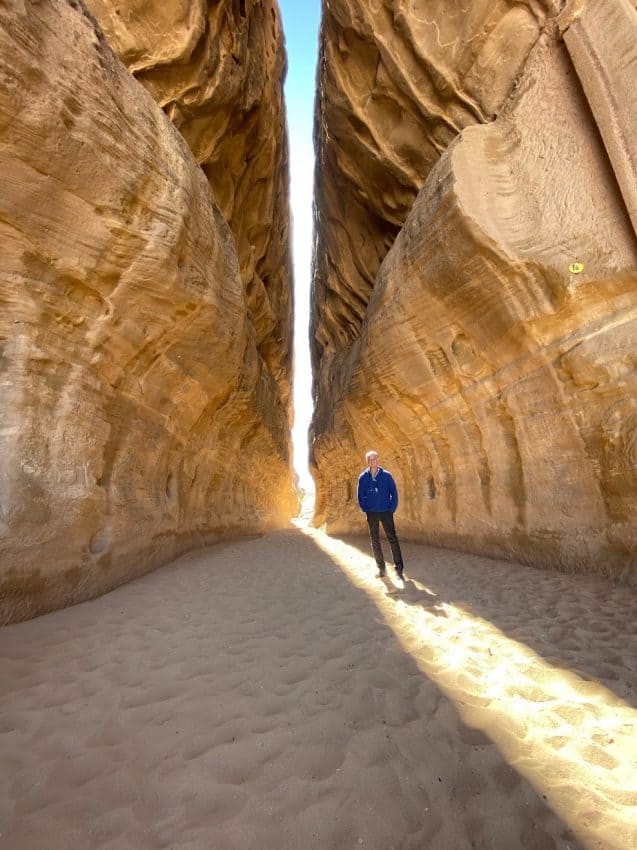
An Easy to get Visa
The plan’s main trigger is the tourist visa. It’s as easy to acquire as a dinner reservation.
I received mine online in one hour and spent 11 days there in February, traveling around the country unimpeded without a government official eyeing my every move.
I started in the capital of Riyadh, flew to Jeddah on the Red Sea coast then flew through Riyadh to Madain Saleh, Petra’s lesser-known sister city with well-preserved ruins from a 2,000-year-old civilization.
I had surprises every day, from fabulous food to friendly people to great beaches to affordable prices. And this was not a surprise: I never saw a crowd of tourists.
Saudi Arabia is charging headfirst into tourism while fending off a worldwide image just a little more positive than deadly viruses. MBS is trying to change that. He dropped the draconian measures outlawing women from driving, traveling alone, and attending sporting events.
Other religions are accepted privately if not legal publicly. Contrary to popular belief, Saudi women never had to wear a burqa and shoplifters never had their hand chopped off.
Saudi Arabia still has a few decades of catching up to do before it’s labeled “accepting.” The concept of free speech remains a moving target and homosexuality and alcohol remain illegal.

Another Planet

But for the intrepid traveler like myself, seeking new pockets in a world that’s getting smaller, Saudi Arabia was like visiting another planet, not just another country.
And I always remember one rule about traveling: The people are not the government.
The Saudi people are as eager as MBS to show the world their nation. One day I was in Jeddah, Saudi Arabia’s seaside jewel of a commercial center. I visited the Naseef House, the beautiful, majestic home of King Ibn Saud, Saudi Arabia’s founding father.
I met a group of local photographers called the Raw Shooters, a friendly, educated bunch in their 20s and 30s. I asked them what’s the one misconception they want to change about their country in the minds of tourists.
“That we are terrorists,” said Sibba, a dental student. “We have oil fields everywhere, like at our houses. That we are gypsies, always aggressive. But we’re always loving. We’re always friendly. We love the insiders and we love outsiders.”
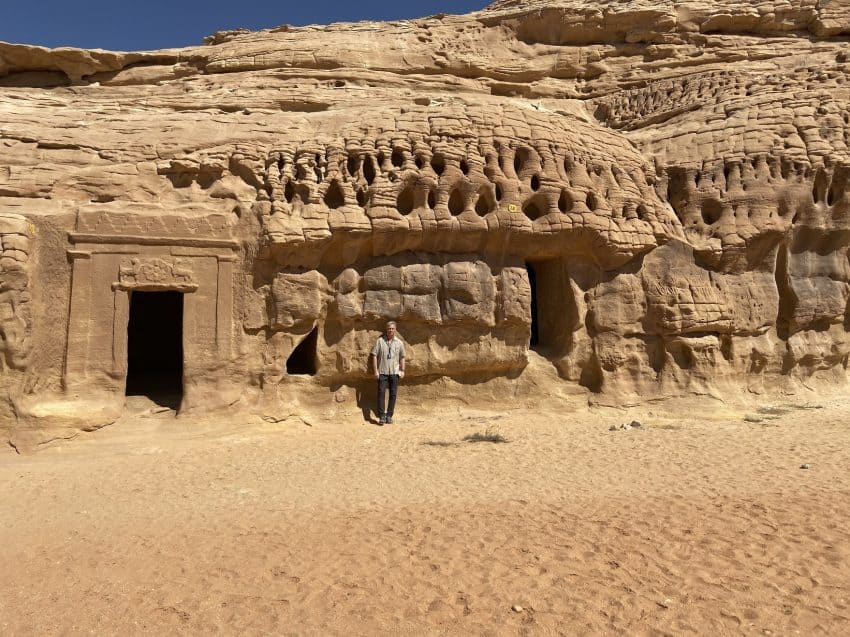 Welcoming Jeddah
Welcoming Jeddah
Jeddah has always been Saudi Arabia’s welcome mat. Since the seventh century, pilgrims came through here on their way to Mecca, 45 miles to the east.
The pilgrimage is one of the seven pillars of Islam and over more than a millennium, Muslims from all over the world have walked under the city’s big stone gate, which has since become a UNESCO World Heritage Site.
The gate leads to Jeddah’s Old Town, one of the most charming in the Middle East. It’s where I walked down uncrowded streets past friendly shopkeepers giving me thumbs up under sheep carcasses hanging from hooks and old men sipping tea at simple wooden tables.
A man in a business suit waved at me from a street corner. I didn’t see one other Westerner in a zone that would be filled with them if in Cairo, Istanbul or Dubai.
An Absence of Tourists
In October and November, the number of visa applications hit between 45,000-60,000. But Saudi Arabia is massive. It’s the 13th largest country in the world, just ahead of Mexico. The absence of tourists I saw in Jeddah’s Old Town didn’t surprise me nearly as much as what I saw the next day on one of the most beautiful beaches I’ve ever seen.
White Sands Beach is a perfect half-moon bay lined with palm trees on water that changes from royal blue to blue-green to turquoise as it stretches to a little man-made island 100 meters offshore. A local beach hand set me up with a padded lanais chair under a wooden umbrella. All afternoon I saw six other people.

White Sands Beach is not cheap. It’s about a 30-minute, $20 Uber ride and about $40 for entry. But the solitude of a gorgeous beach in mild February temperatures around 80 made it worth every riyal.
Bikinis at the Beach
You may not find many people on Saudi beaches but you’ll be surprised at what you will find: bikinis. One night I went to The Zone where numerous hip, coffee shops line the grounds below a tall office building called Beach Tower.
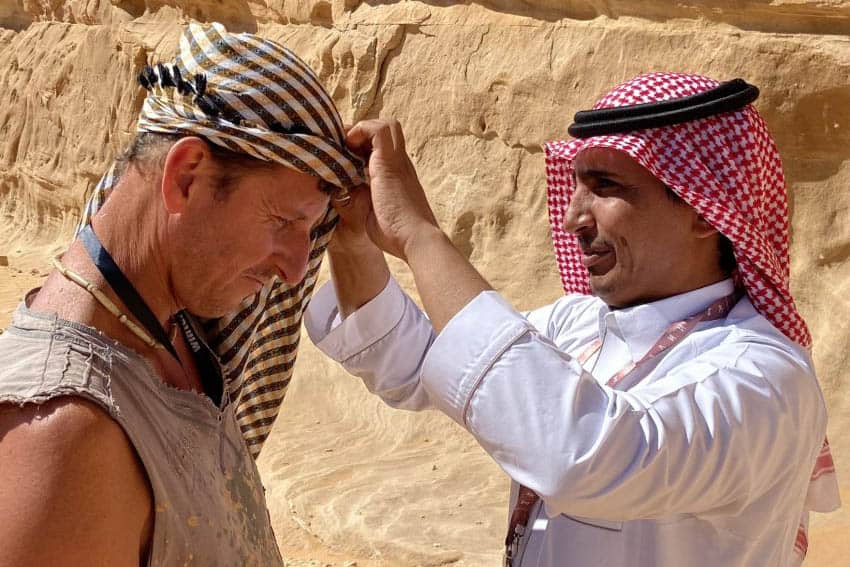
In lieu of alcohol, Saudis are crazy about coffee. Cafes are the watering holes of Saudi Arabia and I found myself at the Med, one of the most popular.
Three young, beautiful Saudi women waved at me, obviously the lone Westerner on a crowded night. They were cousins and only one wore a hijab, the Saudi woman’s headscarf.
They all talked about wearing bikinis to the beach and that the burqa has always been an option and not mandatory. Visiting women are advised to cover their hair, but burqas were in the minority on the women I saw.
“It’s a different culture,” said Nesrin, like her cousins, a nursing student. “They’re very conservative.”
An Oppressed Population?
I asked them about the world’s view of Saudi women and the image of an oppressed population. I also told them a couple days earlier I saw a woman in a burqa driving a Range Rover. They credit MBS whose name always came with smiles or knowing nods every time I mentioned it around Saudi Arabia.
 “Thank God for him!” said Nesrin, holding her arms to the sky.
“Thank God for him!” said Nesrin, holding her arms to the sky.
I asked what they do for fun. “Everything we want, we can find it,” she said.
“Even sex?” I asked.
“If you want to do it before you get married, you can do it,” she said. “And there are many men available. Most of us don’t want to do it before we get married.”
No Burquas in Jeddah
Jeddah has a laid-back beach vibe that reminded me of San Diego with palm trees sprinkled throughout the town and modern apartment houses in colorful wood and bright paint. While I didn’t see many burqas, I didn’t see any flip flops and halter tops, either.
Nowhere does Jeddah stand out as Saudi Arabia’s crown jewel than its Corniche. It’s a 30-kilometer strand that stretches along the sandy beach just north of town. Renovated in 2012, the Corniche is lined with gently swaying palm trees and modern sculptures by the likes of Henry Moore. Couples strolled up the pavement as lights slowly came on. Children rode electric toys along the walkway.
My taxi dropped me off right at sunset, one of the prettiest in the Middle East. Families, couples, groups of men, groups of women, sat on blankets and plastic lawn chairs and ate snacks, drank tea and water, and stared out at the flaming yellow orb setting in a blood-orange sky.
Romance and Saudi Arabia. Who knew?
Riyadh is a Bit Different
While Jeddah is Saudi Arabia’s glittery beach house, Riyadh is its dusty warehouse. This capital city of 5 million doesn’t have the record-breaking skyline of Dubai or the history of Beirut. In fact, when I took the elevator to the 99th floor of the Kingdom Centre, one of its signature skyscrapers, Riyadh reminded me of Los Angeles after a dust storm.
A huge swath of yellowish two- and three-story buildings stretched all the way to the horizon. The air looked like L.A. in the ‘60s but that’s not smog. Locals told me it’s sand. Riyadh is on the edge of the Empty Quarter, a desert covering 650,000 square kilometers or just smaller than the state of Texas, and sand often fills the air there.
Despite the dinginess of the residential areas, this is not a poor city. Before the coronavirus crippled the oil industry and even Saudi Arabia suffered economic cutbacks, its average per capita income was $54,000. Unemployment was under 6 percent. It’s one reason foreign nationals make up 37 percent of Saudi Arabia’s population.
One Product Economy
However, the cutbacks exposed the drawbacks of an economy based primarily on one product. The push to open doors is more important now than ever. I had lunch with one of the men helping to make that happen.
Imad Sulaiman runs Alishitaiwi Travel & Tourism and travels all over the world promoting Saudi Arabia’s new open-door policy. We met in October at London’s World Travel Market where Saudi Arabia had one of the smallest booths in the exposition hall. Syrian born, he has lived in Riyadh for 32 years and worked 15-hour days after the first wave of tourist visas poured in.
His first hurdle is a public relations battle that can only be won by getting people to come.
“They get the wrong image of the country,” he said. “You are here now. How do you feel after two, three days? Everybody has the wrong image of the country but when they come here and discover for themselves, it’s very safe. There are hospitable people.
“Everybody will love it.”
We ate at Nadj Village, featuring the most authentic Saudi food in Riyadh. It’s a chain of five restaurants, each with traditional dining areas where you sit on thick carpets and overstuffed pillows and eat from platters the size of satellite dishes.
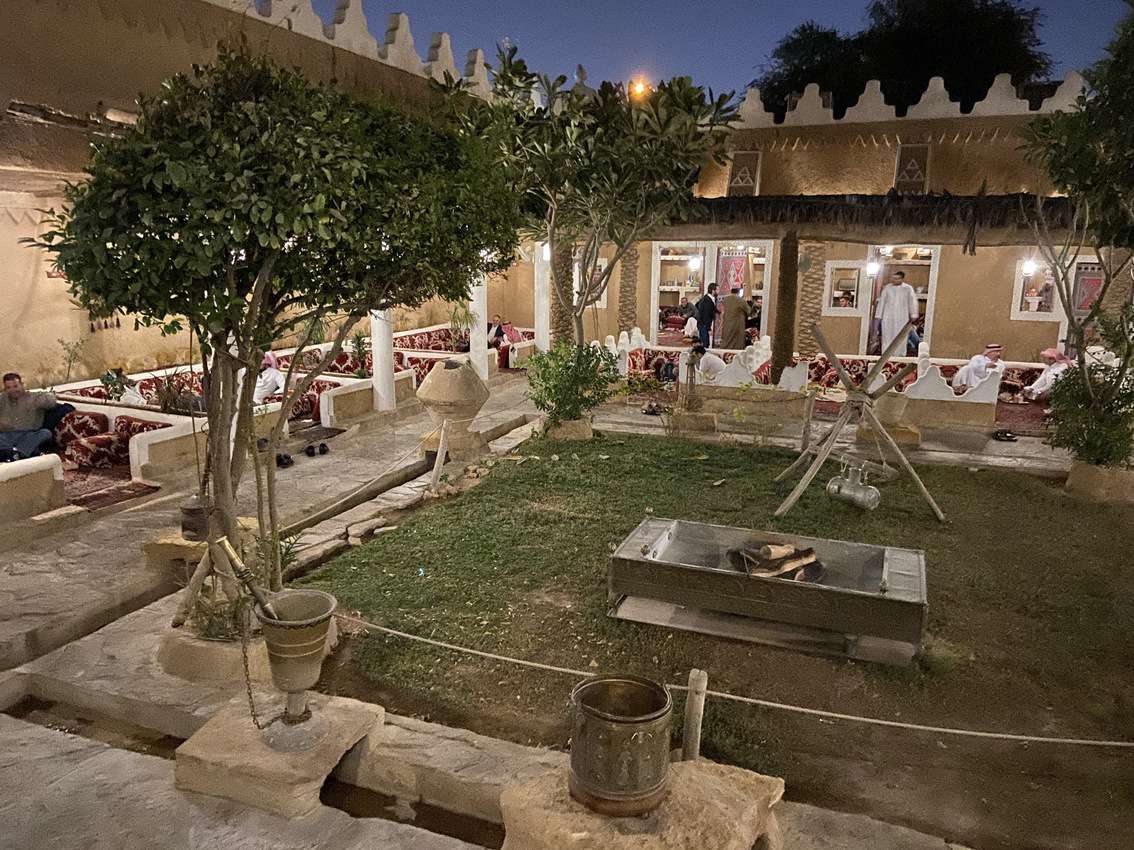 Nadj Village exemplified Saudi Arabia’s surprising array of great, affordable restaurants. My first visit to Nadj Village I had lamb kabash, a classic Saudi dish of lamb, rice, and sultans. With Imad, I ate hashi badya, chunks of camel on a plate covered with rice and side dishes.
Nadj Village exemplified Saudi Arabia’s surprising array of great, affordable restaurants. My first visit to Nadj Village I had lamb kabash, a classic Saudi dish of lamb, rice, and sultans. With Imad, I ate hashi badya, chunks of camel on a plate covered with rice and side dishes.
I drank fruit juice. After 11 days, I did not miss alcohol as I thought I would. Imad said most people don’t.
It’s a New Experience
“They’re very happy because this is a new experience,” he said. “It’s a kind of treatment. People enjoy getting away from alcohol. Alcohol is not everything in life.”
I went to Riyadh’s two can’t-miss sites not far apart. In the middle of its sprawling downtown area, featuring wide, clean boulevards, modest office buildings, and big advertising signs stands the Masmak Fortress. The long, massive sandstone castle, built in 1865, is the site of Saudi Arabia’s birth.
It’s where Ibn Saud, the father of Saudi Arabia, in 1902 led a raid on the fortress and overpowered an army garrison. The end result was the unification of the region’s different kingdoms. As I entered the front door, I could see the spearhead left from the spear Ibn Saud threw to start the attack.
Ubald Civilization
Later I took a taxi to the National Museum, a two-story, modern, complex with a long, chronological display tracing the history all the way back to the Ubald Civilization in 5300 BC. The museum features a 2.75-ton meteorite found in the Empty Quarter and an illustrated history of the Hajj in Mecca, which is still reserved only for Muslims.
But Saudi Arabia has another culture worth studying, and it’s the most important site in the country.
More than 2,000 years ago, in the sands of northwest Saudi Arabia, a civilization existed that was years ahead of its time. The Nabataean people devised one of the most ingenious water-gathering systems and built some of the most elaborate tombs in man’s history. Those 131 tombs still exist today, towering remnants of a city that was a major spoke in the spice trade route from Yemen to North Africa.
Madain Saleh, Sister of Petra
Madain Saleh is the sister city of Petra, Nabataea’s capital, and one of Jordan’s top sites 310 miles to the northwest. Petra gets packed tour buses. I climbed into a modest van with only 11 other visitors. With an excellent guide named Arden, we had Saudi Arabia’s first UNESCO World Heritage Site all to ourselves.
Before I even saw my first tomb, I loved Madain Saleh. It’s at 2,800 feet, which means it is mercifully cooler and can be visited in more months than just late fall and early spring. In summer, temperatures in Riyadh reach 110.
In February, the area around Madain Saleh stayed in the 60s and at night dipped into the low 40s. I finally could wear my black leather jacket I lugged around without wearing it for more than a week.
It’s also in a beautiful valley framed by the huge, craggy, red Hijaz mountains which reminded me of Zion National Park without the tourist signs. For the most authentic experience, my base for exploration was the Rural tents Naseem Alouzaib where I had my own spacious tent right out of a French Legionnaires movie. The collection of tents is on the edge of a vast forest of palm trees with the red rocks forming a beautiful backdrop.
Al-Ula
The lodging was north of Al-Ula (pop. 32,000), the only town in the area and the only place in Saudi Arabia I had to rent a car. However, renting a car from a small airport is not a problem. The beautiful, modern roads through the desert had nary a rock or a hole and remember where you’re driving. Gas in Saudi Arabia was only 75 cents a gallon.
Today, restaurants and hotels are extremely limited in the area. However, I managed to stumble onto a very insider’s experience when I joined two other Americans from the camp at a tiny local diner called Sultana.
That’s where we ate a giant platter of rice, lamb, chicken and falafel for just a few dollars. Then the young man who gave us directions to the diner invited us back to his family’s home where we sat on the floor and drank tea and talked using Google Translate.
No Mass Tourism
After that, Madain Saleh needed to impress me a lot. It did. It’s only about 20 miles north of Al-Ula and a short drive from my tent. Despite the lack of mass tourism, it’s still set up well. The visitors center has the original locomotive from the railway built in 1900 that transported pilgrims from Damascus to Medina, Saudi Arabia’s holiest city behind Mecca. Before the railway, it took 40 days to reach Medina by camel. The train took five.
A short van ride dropped us at a vast site pockmarked with towering rocks, many carved with tombs 50 feet high. The Nabataeans were an ingenious lot. About 450 million years ago, an ocean covered this area. When the ocean receded, water deposited under the sand. The Nabataeans carved wide grooves in the side of these rocks and collected the rainwater in underground wells.
It had a population of 10,000 compared to Petra’s 25,000. However, it had a significant role in the region. The people were also known for their tolerance, allowing all religions to prosper.
“What happened?” one Spaniard asked. Even Arden laughed.
Jokes aside, the tombs are works of art. Each tomb had the eagle god Bushalah atop a triangle. Inside the triangle is a snake to protect the tomb. The Nabataeans started at the top of the tomb with big chisels and worked their way down until they tiny chisels carved the details.
As we gathered in the van to go back, I took a mental picture: a lone van in this vast historical paradise in the desert, in a country opening itself up to a skeptical world.
Time will tell if that picture ever changes, and what it will look like when the world discovers Saudi Arabia.
- Tropea: The Gem of Calabria - July 20, 2023
- Istanbul’s Fascinating Hippie Travelers’ Pudding Shop - May 20, 2023
- Malta is Popular for Making Movies - September 2, 2022


